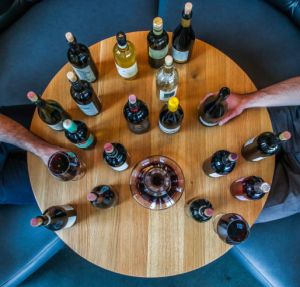
Today’s wine enthusiasts do more than simply drink wine. They organize wine tasting events because they agree with wine connoisseurs who assert that the broader your knowledge concerning wine the more gratifying the experience of indulging in fine wine.
Many wine lovers think a great way to entertain friends is to invite them to a wine tasting event. Before sending out the invitations it’s wise to learn a few facts concerning how best to go about planning such an event. For example, what type of event will you be hosting – horizontal, vertical, blind tasting? Will it be short tasting? What wine tasting order will be established?
1. Wine Tasting Types
Horizontal Wine Tasting
Horizontal wine tasting consists of tasting wines from different wineries that are of the same vintage. Keeping wine variety or type and wine region the same helps emphasize differences in winery styles.
For example, you can include wines like French Bordeaux wines and Napa Valley’s Meritage blends, which are considered Bordeaux-style blends.
You can choose wines from specific areas in different regions – for example, the 2013 Paso Robles Zinfandels. The primary difference will be reflected in the grapes grown – whether these are from the west and east sides of Paso Robles.
Vertical Wine Tasting
Vertical tasting consists of tasting different vintages of the same wine type, typically from the same winery to emphasize notable differences between various vintages. Vintage wines are generally bottled in a single batch so that each bottle will have a similar taste. Climate’s impact on the character of a wine can be significant enough to cause different vintages from the same vineyard to vary dramatically in flavor and quality.
In this type of wine tasting event, your guests would notice differences resulting from the growing environment (what wine experts called terroir), and the affect this has on grapes and characteristics of the wine bottled that year.
Blind Tasting
To ensure impartial judgment of a wine, it should be served blind – that is, without the taster(s) having seen the label or bottle shape. Blind tasting may also involve serving the wine from a black wine glass to mask the color of the wine. A taster’s judgment can be prejudiced by knowing details of a wine, such as geographic origin, price, reputation, color, or other considerations.
2. Short Tasting
A short tasting occurs before before lunch or dinner. Guests follow up during the meal typically drinking one of the wines they select that was included in the short tasting session. Short tasting consists of lining up as many as 8 wines and four or fewer glasses in front of each guest.
You might decide to serve samples of Pepiere Muscadet Sevre et Maine Sur Lie Clos des Briords Cuvee V.V. among other wines in groups of three or four.
It’s recommended you pour 1.5 to 2 ounces per glass. This gives each guest enough wine to taste with some left over to be served later.
3. Wine Serving Order
Wines are usually served in the following order: Sparkling Wines, Dry Whites, Heavier and older Whites, Rosé wines, Younger Light Red, Bold and high liquor red wines, Bold and high alcohol red wines, Sweet dessert and Ice Wines.
For instance, you can serve a sip or more of your Riesling Pinot Grigio, followed by a Sauvignon Blanc, then a Gewurztraminer, and lastly a Chardonnay. Whites are served before reds, and reds before sweet wines.
Why Whites before Reds, and Reds before Sweet Wines?
This is done to insure tastings complement each type of wine. It’s preferred that you progress from lighter wines to more full bodied to denser and sweeter wines. Starting with drier, heavier wines allows your guest to savor the more subtle notes of light wines. Another factor is sweet wines cause dry wines to be more acidic and less likely to be enjoyed if they are not presented before sweeter wines.
How best to taste
When attending a wine tasting that doesn’t utilize black glasses, make a visual check of the wine under neutral lighting. Breathe through your nose and identify the aroma of the wine. Assess the taste structure of the wine, and swirl the wine gently in your mouth to engage all taste buds before swallowing.
Shift Frequency © 2019 – Educational material
